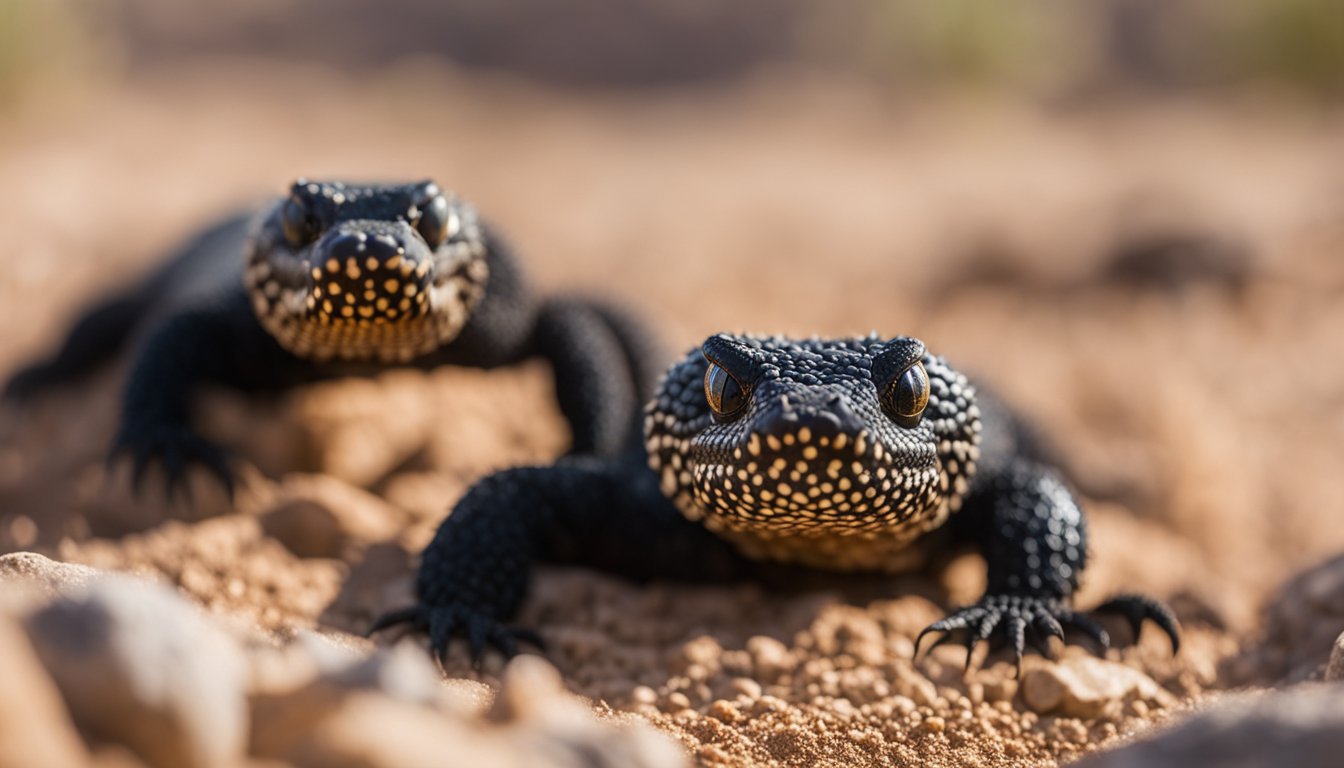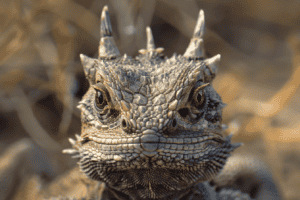Gila monsters are one of the most fascinating creatures one might be fortunate enough to cross paths with in the wild, should they adventure into the southwestern United States or northwestern Mexico.
Named after Arizona’s Gila River basin where they were first discovered, these hefty lizards carry a certain mystique, partly due to their venomous bite.
With their bumpy, bead-like skin that looks like a kaleidoscope of black, pink, orange, and yellow, these slow-moving lizards seem like they’ve wandered straight out of a child’s vivid dream.

Despite their fierce name and reputation, Gila monsters have a relatively shy demeanor, spending much of their lives hidden away under the ground away from the heat.
They are the largest native lizard species in the United States, but don’t let their size intimidate you; they’d much rather avoid confrontation.
These creatures are a unique blend of danger and beauty, sporting chunky bodies that can grow up to two feet long and a forked tongue they flick in and out to taste the air around them.
While they may not be the cuddliest of pets and their venomous nature commands respect, Gila monsters hold secrets that scientists are eager to understand.
How does the venom work? Could it have medical benefits for humans? What can these living fossils tell us about evolution?
As one delves into the world of Gila monsters, it becomes clear that they are more than just a venomous marvel—they’re a window into a world that has existed for centuries.
They remind us that even the most seemingly fearsome creatures have a place and purpose in the delicate balance of our planet’s ecosystems.
Mysteries of the Gila Monster
Have you ever wondered about the secretive lives of Gila Monsters?
These venomous creatures have puzzled scientists for years with their unique characteristics and elusive habitats.
Let’s peel back the layers of mystery and take a peek into the world of the Gila Monsters.
Origins and Habitat
The Gila Monster, one of only a handful of venomous lizards, calls the Southwestern United States and Northwestern Mexico its home.
With a preference for arid climates, they’re often found in scrublands and desert regions.
Researchers studying these creatures have mapped their presence across Arizona, California, Nevada, Utah, and New Mexico.
This reptile’s origins are deeply grounded in these hot, sparse landscapes, where it has adapted impressively to scarcity of water and food.
Physical Characteristics
Picture this: a thick-bodied lizard, covered in bead-like scales shimmering in a kaleidoscope of black, pink, orange, and yellow patterns.
Hefty for a lizard, the Gila Monster can grow to about two feet in length and tip the scales at nearly five pounds.
Their tails are like pouches, saving up fat reserves that help them to survive in their harsh environment.
But it’s their venom that really sets them apart.
Gila Monsters have grooved teeth on their lower jaw, through which they channel their venom into their prey—a defense mechanism that would fascinate any budding herpetologist.
Even their scaly skin is a marvel, with each bead-like osteoderm playing a role in their survival.
The Venom Factor
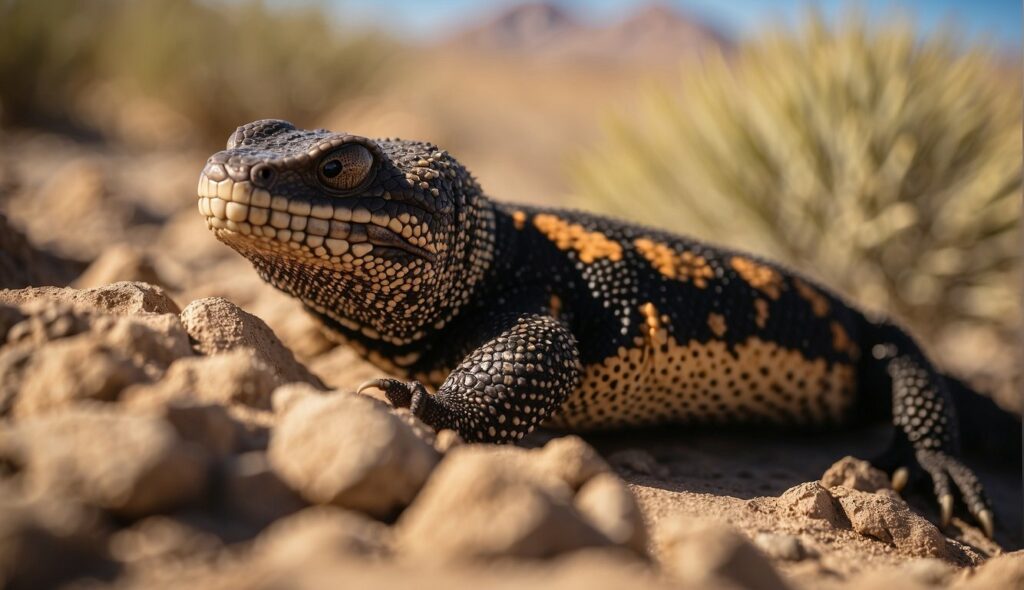
Gila monsters are one of the few venomous lizards in the world.
Their venom is a vital aspect of their biology, used for both self-defense and subduing prey.
What Is Gila Monster Venom Made Of?
The venom of a Gila monster is a complex cocktail of proteins and peptides, some of which can be quite toxic to their prey.
It’s not as potent as that of some snakes, but it can cause significant pain and swelling in humans.
The Gila monster has specialized grooved teeth in their lower jaw that deliver this venom when they bite.
As they chew, the venom seeps into the wound, facilitating the immobilization of their dinner.
What’s fascinating is that the venom of Gila monsters is relatively understudied, promising an exciting field of research for scientists.
Survival and Defense
For Gila monsters, their venom is not just for capturing a meal; it’s a crucial part of their survival strategy.
Imagine you’re a predator, eyeing a Gila monster – you may think twice about attacking if you know about the painful bite that awaits you.
This venomous defense mechanism discourages potential predators and allows the Gila monster to survive in its harsh desert habitat.
Unlike many animals, they don’t have to bite to defend themselves; just the threat of their venomous bite is usually enough to keep enemies at bay.
Gila Monster Venom Human Medical Potential
While Gila monster venom can be harmful, it also holds incredible therapeutic potential.
Researchers have found that a peptide in the venom, called exendin-4, resembles a hormone in the human digestive system, which is key in regulating blood sugar levels.
This finding led to the development of a drug called exenatide, used to treat Type 2 diabetes.
The discovery illustrates that Gila monster venom isn’t merely a survival tool for the lizard, but a possible life-saving substance for humans.
Through understanding the Gila monster’s venom, its composition, role in survival, and contribution to medical science, one can appreciate the intricate connections between nature and human innovation.
The Gila monster exemplifies the mystery and magic hidden within seemingly small elements of the natural world.
Conservation Efforts
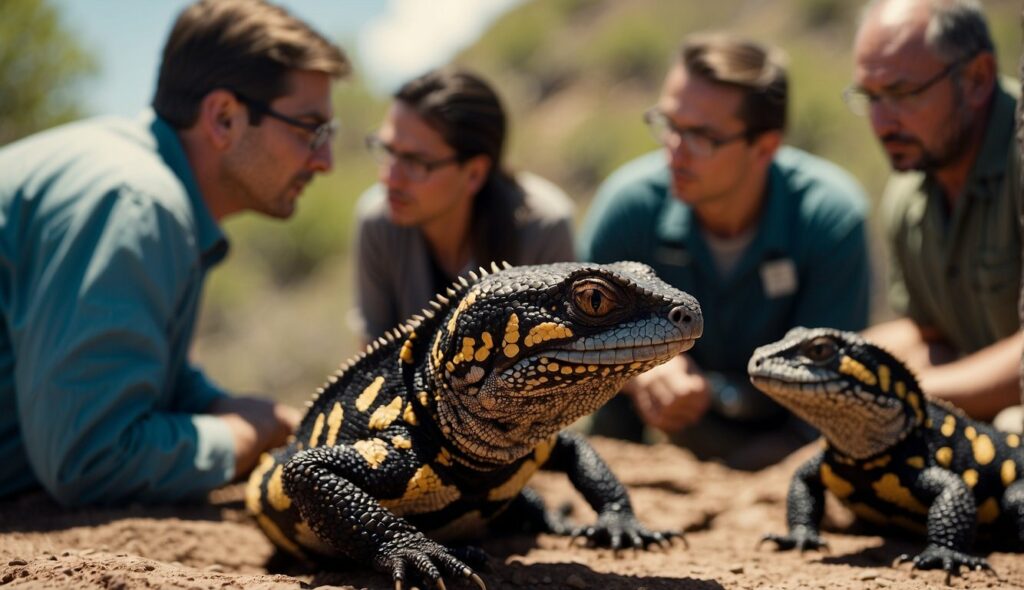
The future of Gila monsters hangs in the balance, but there are shining beacons of hope in the form of focused conservation efforts.
They’re aimed at ensuring these unique creatures continue to thrive, despite the challenges they face in the wild.
Habitat Preservation
Habitat preservation is the cornerstone of Gila monster conservation.
These creatures need plenty of space and the right conditions to flourish.
Specifically, they rely on the arid and semi-arid habitats of the Southwestern United States and Northwestern Mexico, which provide the necessary warmth and shelter.
Conservationists and scientists are studying these habitats to understand exactly what Gila monsters need to prosper.
They monitor factors like temperature and vegetation, making sure to preserve the delicate balance of their natural environments.
Legal Protections
Legal protections shield Gila monsters from the threats they face, primarily from habitat loss and the illegal pet trade.
Hefty fines and legal consequences are now in place for those who attempt to harm Gila monsters or their ecosystems.
They’re listed under Appendix II of CITES (the Convention on International Trade in Endangered Species of Wild Fauna and Flora), which regulates their trade and ensures international cooperation in their conservation.
Examples of Legal Protections:
- The Gila monster is protected under state laws such as Arizona’s Game and Fish Department regulations that prohibit collection or killing.
- Federal laws, including the Endangered Species Act, may come into play for protecting the Gila monster’s habitat on public land.
Frequently Asked Questions About Gila Monsters
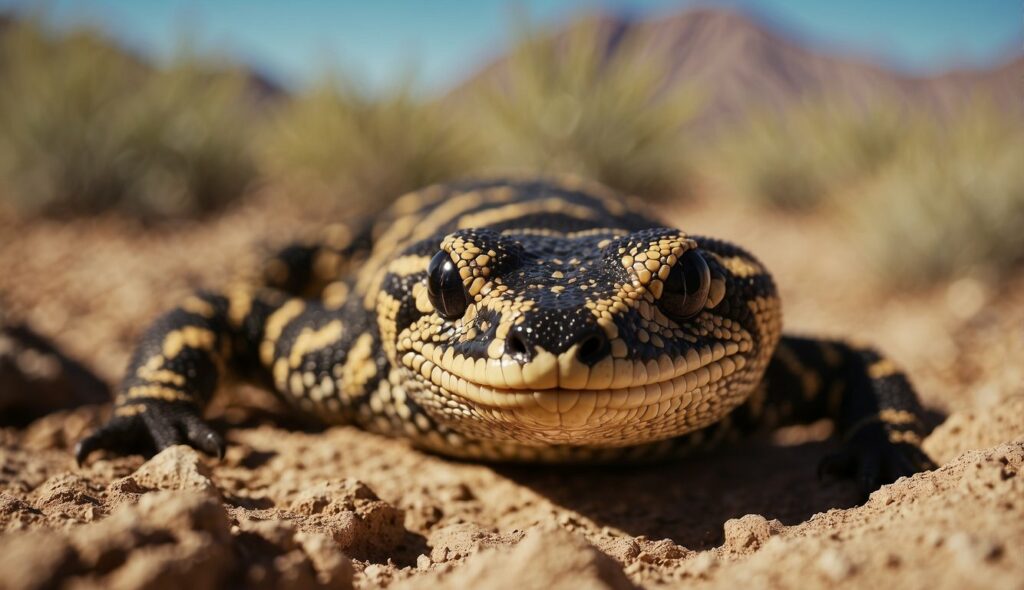
What happens if you’re bitten by a Gila monster, and how do you treat it?
If a person is bitten by a Gila monster, they may experience swelling, pain, and a drop in blood pressure.
These bites are rarely fatal to humans, but medical attention should be sought immediately.
Treatment typically involves cleaning the wound and providing supportive care to alleviate symptoms.
Though Gila monster bites are not common, it’s wise to exercise caution when in their presence.
Are Gila monsters the only venomous lizards, and if not, who are their venomous relatives?
Gila monsters are not the only venomous lizards.
They share this characteristic with their close relatives, the beaded lizards, found primarily in Mexico.
Another distant but noteworthy cousin is the Komodo dragon, although its venom is weaker.
Together, these creatures make up a small group of venomous lizards known for their distinct method of delivering toxin.
What does a Gila monster eat, and how does its diet influence its behavior and habitat?
Gila monsters feast on a diet mainly comprised of eggs, small birds, and mammals.
This diet influences their behavior, leading them to be slow-moving and to conserve energy.
They often dwell in arid environments like deserts and scrublands where these food sources are available.
The scarcity of food in such habitats makes their energy-efficient lifestyle a necessity.
How does the venom of a Gila monster work in its prey’s body, and is it dangerous to humans?
The venom of a Gila monster acts on the prey’s nervous system and circulation.
While it is potent enough to immobilize small animals, its effect on humans, while painful and potentially uncomfortable, is typically not life-threatening.
It serves as a defense mechanism and as a means to subdue prey for these remarkable lizards.
Where can you find Gila monsters in the wild, and what is their natural habitat?
Gila monsters are native to the southwestern United States and northwestern Mexico.
They favor scrubland and desert habitats where they can burrow underground.
These lizards are most often found in areas with abundant shelter and food sources, such as under rocks or in the burrows of other animals.
Why are Gila monsters often misunderstood, and what are some common myths about them?
These elusive lizards are often misunderstood due to their venomous bite and elusive nature, leading to myths that exaggerate their danger.
A common misconception is that Gila monsters can spit venom or chase humans; however, they are reclusive and will likely avoid confrontation.
Education and awareness can dispel these myths and foster a greater appreciation for the unique place Gila monsters hold in the ecosystem.

